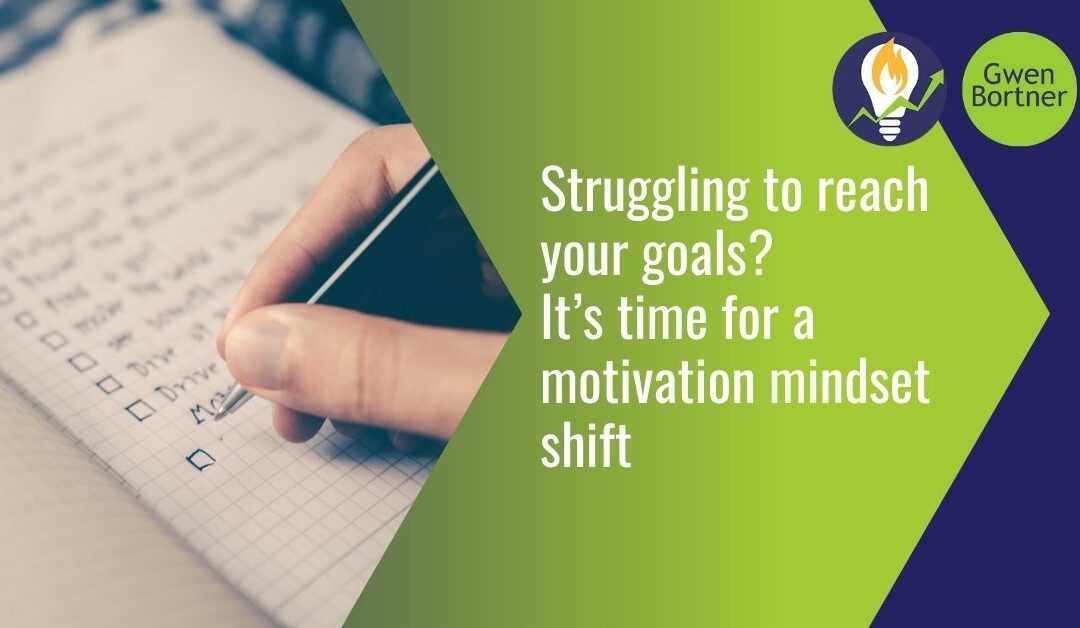
by Gwen Bortner | Tasks & Goals, Training & Instruction
How happy are you with the way you typically set goals for your business? Do you keep your goals once you’ve set them, or do you struggle to follow through? In my last post, I outlined the crucial first step in the goal-setting process: quarterly review. Today, I’m walking you through what to do once you’ve completed your review, and you’re ready to sit down and set your goals.
Most people are actually pretty bad at setting goals: they tend to default to one of two options, neither of which are great. The first option is to set a goal that is so easy to reach, that there’s no real challenge involved. Then they don’t end up seeing any real growth, because the goal wasn’t ambitious enough. With the other option, some folks set goals that are too ambitious, to the point where they’re almost impossible to reach. Then they get easily discouraged because they never feel like they’re getting anywhere. Most entrepreneurs fall into the second category, in my experience.
This is why it’s so important to look at real data before you set your goals, and then to make sure the goals you set are intentional and logical as well as aspirational.
Not One Goal, But Three: Good/Better/Best
Earlier in my career as an entrepreneur and CEO, I participated in Todd Herman’s 90-Day Year goal-setting program. During this time, I learned about the concept of good/better/best goals. I still use this process in my own goal-setting, and I encourage it for my clients as well.
In this type of goal, you have three levels:
- A good goal is one that would yield a satisfactory result, and reaching it isn’t completely out of the realm of possibility. With this type of goal, you should be able to reach it around 80-90% of the time, barring unforeseen circumstances. You should be willing to bet a thousand dollars on reaching this goal, but it shouldn’t be so easy that reaching it is just an absolute default guarantee.
- A better goal is something that will be a stretch, but also still possible. You should definitely feel like you’re pushing yourself to be able to reach this goal, but in the end, you should actually reach it between 40 and 50% of the time. This type of goal is possible, but not easy.
- A best goal is one where if you reached it, you would probably pass out from the excitement. It’s still feasible, but very unrealistic. Reaching a goal like this only happens 5-15% of the time, because several factors have to line up for you to hit that goal. (Note: This is where entrepreneurs often set their only goals, and that’s why they get discouraged because they almost never actually reach those goals.)
Set the Right Types of Goals
Using the data from your review, choose one to three areas of your business that you want to work on for the coming quarter. For each area, you’re going to set a good, better, and best goal.
Before you actually write down your goal, consider this: there are only two types of goals you can set, and you will want to be intentional about the type you choose. Activity goals are things you will do, while outcome goals are results you will see. For example, an activity goal is, “I will write a newsletter every week.” An outcome goal is, “My newsletter will have a 50% open rate every week.” You can control an activity goal, but you can’t fully control an outcome goal.
Both types of goals are valid, but when you’re setting your goals, it’s important to have at least one outcome goal that will positively influence your business. The outcome goal is often just about income, and it will be tied to activities, but the outcome is the goal you should reach for.
Think about it this way: if you set an activity goal, and you do the activity, what happens next? The outcome is uncertain, but if you do not see any positive results from your efforts, you’re stuck in a holding pattern. On the other hand, if you set an outcome goal, you will naturally change up the activities you try until you find the “magic formula” that yields the outcome you were after. You’ll be more likely to achieve success because you were pursuing an outcome rather than checking an activity off your To-Do list.
For each area, you identified to work on, set a good/better/best goal, and try to make sure that most of these are outcome goals.
Check-in: Do these goals feel right for you?
If you have three major outcome goals with good/better/best levels for each one, that’s a good place to start. However, it’s important to take a look at those goals and examine them with a critical eye. Can you reasonably work toward all three goals at one time? Will reaching those goals bring you the growth or stability you’re after in your business? Is it a stretch that will challenge you without overwhelming you? Do these goals line up with your vision and mission?
One final item to consider: Is there a goal that you need to set around your own behavior, that would move your business forward? Maybe you need to look at your finances every week, delegate more work and stay out of it, or thank a different employee for something specific every day. As the CEO of your company, nobody performs an annual review for you, so you’ve got to do it for yourself. Personal development should always be part of your goal-setting process, so while you’re listing your goals, make sure to pick one thing that you could be doing better and add it to the list.
Do you want some support in setting strong goals and holding yourself accountable for working toward them?
Let’s talk about how our Quarterly Tune-Up sessions may be the perfect fit to help you set your goals and keep with them.
Click here for more information to schedule a conversation with Gwen.

by Gwen Bortner | Tasks & Goals
In my work as a consultant, I talk to my clients about goal-setting all the time. You probably set goals regularly, both formally and informally, but how many of those goals do you actually reach? If you’re having problems in this area, chances are you just need to change your mindset about goal-setting and motivation.
Do any of these scenarios apply to you?
- You set a goal and you feel really excited about it, but only for a short period of time. Eventually, your enthusiasm fizzles out, and you’re left feeling defeated because you couldn’t reach the goal.
- You set a goal but you have no idea how to actually achieve it, so you get overwhelmed and start to think that maybe the goal just isn’t possible for you.
- You feel like you should be setting more goals for your life or business, but you can’t really figure out what those goals should be.
If you saw yourself in any of those scenarios, keep reading, because this post is for you.
Change your WHY
When you set a goal, what is the reason for it? If you can’t think of one, or the reason is because someone else suggested it (you read about it in a blog post, or that’s what “everyone” is doing, or you have seen it work for other people so you assume it will work for you), it may be time to set a new goal. Doing something because that’s what other people expect, or because it seems like the right idea, is rarely going to give you enough motivation to achieve it.
Maybe you DO have a reason for your goal, though. Do you want to earn enough money in your business so you can quit your day job? Do you want to get 100,000 followers on Instagram so you can partner with other brands? Do you want to earn enough money to buy a ski condo for family vacations?
Those are all great goals, and perfectly valid reasons. The problem is, sometimes those reasons just aren’t enough to really motivate you to reach that goal. It’s easy to get comfortable with what you have, which then causes you to lose the motivation to get what you want.
What have you got to lose?
Take the first example – replacing your day job would be great. But that day job, no matter how much you may dislike it, represents a source of security: a regular income and the safety of knowing what to expect every day. When you have that day job, it can be hard to put in the work to build your business to the point where you can replace that income. You might lose the motivation for such a big goal before you actually reach it.
Now think of it this way: what if you suddenly and unexpectedly LOST your day job? In that situation, I bet you’d find a way to grow your business a lot more quickly, wouldn’t you?
To reframe your mindset about motivation, stop thinking of what you want. Instead, think about what you stand to lose if you don’t reach that goal.
Nothing about your circumstances has to change at all, but if you can figure out the stakes in your own situation, it becomes easier to motivate yourself to reach a goal. Find something you don’t want to lose, and you’ll be much more motivated to make a change.
For me, this change came after my dad died. I realized that when he was sick, near the end, it cost my mom a lot of money to provide for his care. I also realized that it would probably cost me even more money in the future to provide for my own medical or elder care needs, because I don’t have children to help support me when I reach that stage in my life. Knowing that I needed to start getting serious about my retirement savings prompted me to make a major change in my business: teaching knitting classes wasn’t going to cut it if I wanted to live out my retirement years in comfort.
Nothing changed about my circumstances when I made this shift in my goals: I have never had (or really wanted) children, so this was not new information. I have always known that my family has given me good genes, so I can expect to live a long time. But it wasn’t until I really thought about these things, and the risk I would take by not making better plans for my retirement, that I really kicked my motivation into high gear.
Think of it this way: most people don’t get serious about their health until they have a medical scare. What’s the “scare” you can give yourself about your business in order to help increase your motivation to grow that business?
The Motivation Equation
Once you’ve got clarity about your goal and the motivation behind it, it’s time to make sure that those two things match up. Here’s an equation I like to use:
M4R > Fe
What this means is that the motivation for your result (M4R) in any goal needs to be greater than the force, energy, or effort (Fe) required to achieve it.
Motivation for the Result (M4R) > Effort to achieve the Result (Fe)
If your goal is too large, and your motivation isn’t enough to help you get there, then you’re going to lose steam and probably fall short of reaching your goal. One way to help with this is to think about what’s at stake if you don’t reach the goal, as I talked about at the beginning of this post. Another option is to make sure you set goals that are manageable, and equal to the amount of motivation you have for them.
Resize Your Goal
If your goal is too large, it can take a lot of time and energy to reach it. Your motivation has to be really strong to reach that kind of goal, and most of us just don’t have that much motivation stored up. If that’s the case for you, then consider breaking your big goal into smaller increments, and set each increment as its own goal. Not only will this help you see progress faster, but it will also give you a chance to take a break along the way, and re-evaluate whether you still want to keep striving toward your initial, larger goal or whether it’s time to go in a different direction.
Instead of earning enough to replace your day job salary for a full year, start by earning enough to replace one month, then three months, six, etc. Instead of earning enough to buy a condo, try saving enough for the down payment, and then see if you can bank the mortgage payment every month for three months. If you don’t have an emergency situation to motivate you, set goals that are more do-able, and then stop to re-evaluate along the way.
Before you set your goals, take a minute to make sure that your motivation matches the amount of work you’re going to have to put in to get there. Reaching a big goal isn’t ever going to be easy, but when you reach those rough patches, remembering your motivation can be a good way to keep yourself on track.
If you’d like some feedback about your goals or some help finding the motivation, click here to book a consultation with me, and I’ll help you figure out how to balance the Motivation Equation for your business.




